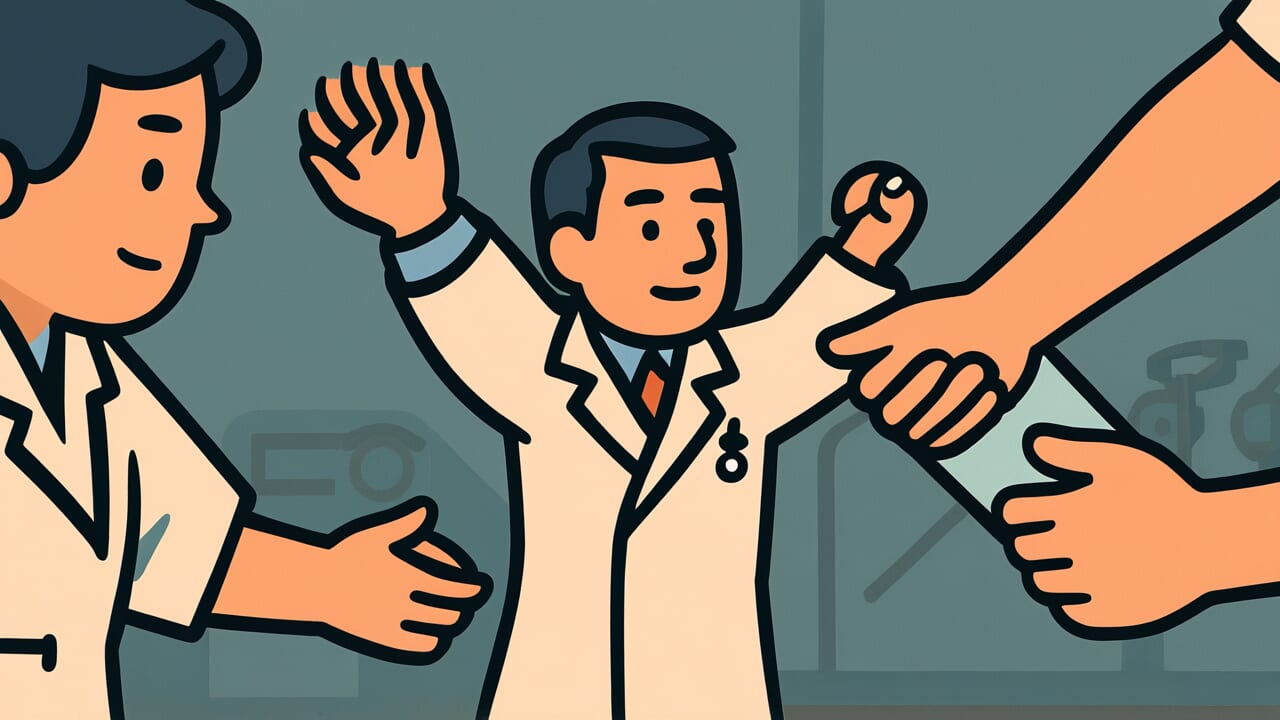How to Read “Break your elbow three times and become a good doctor”
Sando hiji wo otte ryōi to naru
Meaning of “Break your elbow three times and become a good doctor”
This proverb means that by experiencing repeated failures, you gain deep expertise and knowledge in that field.
The metaphor comes from the idea that if you break your elbow three times, you’ll know more about treatment than anyone else. Through such painful experiences, you become a good doctor.
People use this saying to encourage those who fear failure. It’s also used to teach the importance of learning from mistakes.
This proverb is especially relevant when learning technical skills. Failure is unavoidable in the learning process. In fact, those failures become the foundation for growth.
In today’s world, perfectionism and fear of failure are strong. This makes the proverb’s message even more important.
Don’t give up after one or two failures. Use those experiences to build real ability. This idea applies to learning and work in any field.
The proverb teaches us that failure isn’t shameful. It’s actually a stairway to becoming an expert.
Origin and Etymology
This proverb has several possible origins. The most likely theory traces it back to ancient Chinese classics.
The expression “三折肱為良医” appears in old Chinese texts. This phrase likely came to Japan and took root there.
“肱” refers to the elbow. “Breaking your elbow three times” means fracturing it three times.
Why the elbow specifically? The elbow is a joint we use constantly in daily life. If you break it, you experience the entire treatment process intensely.
Break it three times, and you’ll know the pain, treatment methods, and recovery process firsthand.
The choice of “three times” is interesting. Once might be coincidence. Twice might be bad luck.
But three times? That means the experience has truly become part of you. This thinking lies behind the number choice.
In Japan, the number three often carries meanings of completion or mastery. “Third time’s the charm” is another example of this pattern.
The choice of doctor as the profession is also meaningful. Medicine is a specialized skill that involves human lives. It’s a field where failure cannot be tolerated.
That’s why this proverb brilliantly expresses a paradoxical truth. Repeated failures are what create true experts.
Usage Examples
- He failed at starting businesses many times. But break your elbow three times and become a good doctor—now he’s a successful management consultant.
- I keep failing at cooking. But they say break your elbow three times and become a good doctor. This experience will surely help me in the future.
Universal Wisdom
This proverb speaks a universal truth. Pain is essential for human growth.
We instinctively try to avoid failure. But failure actually brings the deepest learning. Why?
Success gives us only surface-level understanding. Failure forces us to ask the fundamental question: “Why didn’t this work?”
The number three reveals an important insight. One failure doesn’t show you the essence of the problem.
After one failure, people think “I was unlucky.” After the second, they say “I’m still not used to it.”
But by the third time, you can’t blame chance or bad luck anymore. Only then do you face your shallow understanding and immature skills head-on.
This proverb has been passed down for generations. Why? Because humans naturally seek the easy path.
Everyone wants to succeed without struggle. But our ancestors knew better. True expertise only comes from accumulated painful experiences.
They used the concrete, painful image of breaking an elbow for a reason. They wanted to strongly impress upon us this truth: the memory of pain transforms into wisdom.
When AI Hears This
In Bayesian inference, you start with an initial prediction (prior probability). Each time you add data, the probability updates and moves closer to truth.
Here’s the key mathematical fact: one update is never enough.
Imagine a doctor who breaks their elbow once. They become 90% confident they can diagnose “this symptom is a fracture.” But then they’re wrong—it’s a different condition.
This single failure updates their prior probability. But uncertainty remains high. Why? Because that one case might be coincidence.
After the second failure, they start thinking “Maybe my judgment criteria are wrong.” By the third time, they finally have statistically significant evidence.
Bayesian statistics requires multiple data updates for reliable conclusions. One observation is easily affected by error or chance. Two is still insufficient.
Only after three or more repetitions do patterns begin to emerge. This is called “the sample size problem.” Too little data prevents accurate estimation.
The number “three” has been passed down through experience. But it actually matches the minimum number of updates probability theory requires.
The human brain unconsciously performs Bayesian inference. This proverb has been putting the brain’s learning mechanism into words all along.
Lessons for Today
Modern society tends to judge failure harshly. On social media, people share only success stories. Failures are hidden.
But this proverb teaches you something important. Failure isn’t shameful. It’s a required course on the path to becoming an expert.
Young people especially need to hear this: early failures are the most valuable. If you’re going to break your elbow three times, better to do it while you’re young.
Your bones heal faster then, right? Experiencing many failures early in your career becomes the foundation for later success.
Fearing failure and not trying at all—that’s the biggest opportunity loss.
This proverb also suggests something about the “quality” of failure. Don’t just repeat the same mistakes mindlessly. Learn something from each failure.
Each of those three failures becomes a step bringing you closer to becoming a good doctor.
Right now, if you’re challenging something and failing, that’s proof you’re walking the path to expertise. Treasure that pain.
Someday when you look back, you’ll realize those failures were your best teachers. That day will definitely come.



Comments